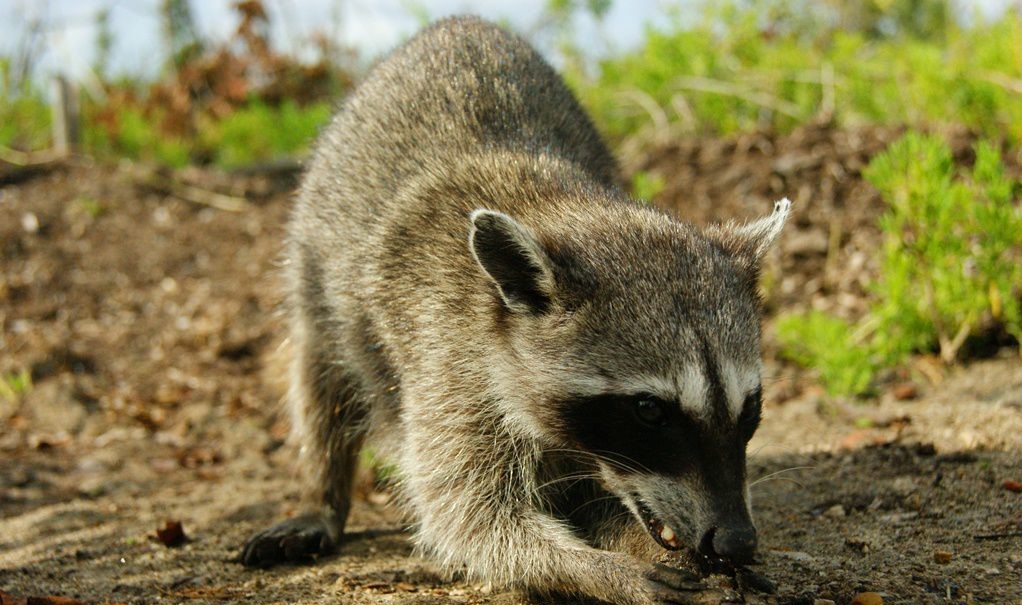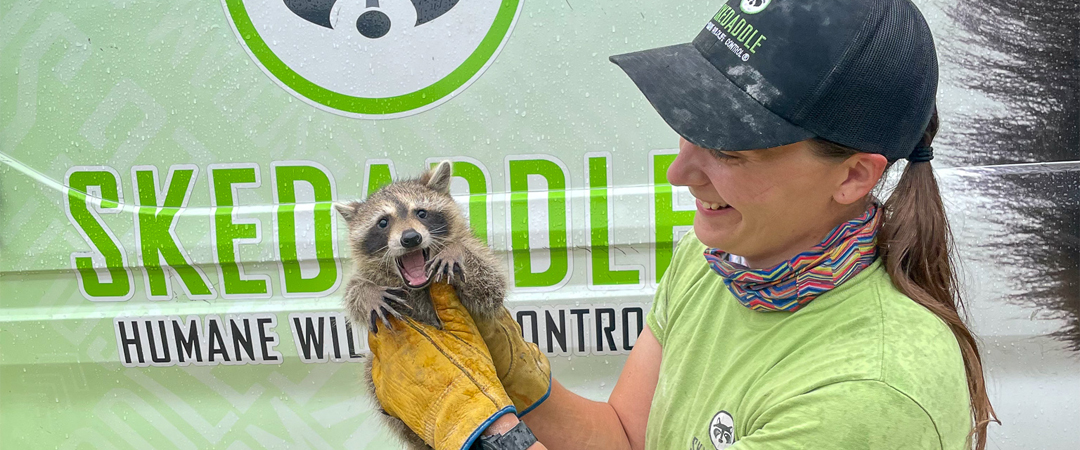If you’re a homeowner, you’ve more than likely encountered the ring-tailed bandit — the raccoon. As intriguing as these nocturnal animals are, their unscheduled visits can become troublesome. But before you start considering raccoon removal in Anne Arundel, it’s time to get to know them better. Let’s unravel some fascinating facts about our furry foes to give you a deeper understanding of their behavior, just how smart they are, and why they might choose your home as their next hangout spot.
Fun Facts About Raccoons!
As homeowners in Anne Arundel, we often view the masked bandits as unwelcome guests. But there’s so much more to these masked bandits than meets the eye. Before you call Skedaddle Humane Wildlife Control for raccoon removal, why not spend a moment to learn more about these intriguing animals? That way, your next encounter with a raccoon may hold an element of fascination rather than pure annoyance. So, ready to gain some insight? Let’s dive in!
1. Nightlife: The Nocturnal Adventures
Did you know raccoons are part of the night owl clan? Yes, these intriguing suburban explorers are nocturnal animals. This means they are most active after sunset and before sunrise, making the night their lively playground.
Their nocturnal nature is a strategic move on their part. Nighttime offers fewer threats allowing them to rummage for food freely. They rely on their excellent night vision for their nocturnal adventures, finding their way around with ease even in the most dimly lit areas. Don’t be surprised if you find traces of their night escapades in your backyard or garbage bin in the morning!
So, if you’re hearing suspicious rummaging noises in the late hours, don’t judge too fast – it might be just a raccoon satisfying its midnight snack cravings. Keep this fun fact in mind when encountering our masked, nocturnal neighbours.
2. The Masked Mastermind: Unleashing Their Intelligence
You may not realize it, but raccoons are surprisingly clever mammals. In fact, their intelligence level is commonly compared to that of primates. Don’t let their seemingly innocent and fluffy appearance fool you. These animals are keen problem solvers, known to tackle complex tasks to get their ‘hands’ on a tasty meal.
Take, for instance, their dexterity. They have highly sensitive and flexible front paws, which they utilize much like humans use their hands. They can open locks, twist door knobs, and even rummage through your trash can lids. Give them a challenge, and more often than not, these furry fellows will solve it.
If you thought that was impressive, their memory is just as notable. They don’t easily forget. Researchers have found that these animals can remember the solutions to tasks for up to three years. So, if they’ve found an easy meal at your place once, it’s pretty likely they’ll return.
Understanding their intelligence is key to handling them more effectively. When you admire them from a safe distance, you might find that their curious nature and problem-solving skills are, in a way, admirable.
But remember, while they might be smart, they can also cause a considerable amount of damage when they wander into residential areas. So, it’s always in your interest to contact Skedaddle if you find one of these intelligent animals creeping into your home. Our experts know just how to handle these smart little bandits humanely.
3. A Gourmet Palette: What They Love to Eat
It’s time to delve into the dining preferences of our furry friends, the raccoons. Their diet is surprisingly diverse and demonstrates their adaptability to different environments and food sources.
- Wild Foods: Fruits, berries, acorns, and grubs are all part of a raccoon’s natural menu. They’re also known to catch a few small rodents and birds. While they’re known for their fishing skills, freshwater fish such as crayfish are their particular favorites.
- Human Foods: Here’s where things get interesting. These opportunistic eaters are quick to dig into anything left available. This includes trash cans, pet food, or your unattended picnic. These animals seem to enjoy almost anything— leftovers, fruits, vegetables, and sweets. It’s this adaptability that often brings them into contact (and conflict) with us humans.
- Urban Foraging: Raccoons in populated areas may also forage in gardens and crops, enjoying vegetables and grains with a side of mischief.
- Seasonal Eating: They adapt their diet seasonally. In the spring, they lean towards protein-packed meals like insects, frogs, and eggs. But in the fall, they binge on fruits and nuts to fatten up for winter.
Remember, enticing a raccoon with food around your home is a not-so-friendly invitation to wildlife invasion. To coexist peacefully, manage food waste properly and consider animal-proof containers and enclosures for your gardens and pets’ food bowls!

4. Little Hands, Big Trouble: The Raccoon’s Dexterity
So, why exactly are raccoon’s little hands big trouble? Well, if you’ve ever seen one in action, you might know they are incredibly adept with their front paws. What makes them so proficient, you ask? Their paws are not just a little unique; they’re a wonder of nature’s engineering.
Raccoons have five toes on each of their front paws that work much like our own fingers. They’re very flexible, allowing them to grip and manipulate a wide variety of objects. But the truly remarkable thing lies in their sense of touch. Even without the aid of sight, they can identify an object just by touching it, thanks to a dense network of sensory nerves in their hands. And unlike other mammals, their sense of touch isn’t hampered when their paws are wet. In fact, water can actually heighten their tactile sensitivity!
Their dexterity combined with powerful claws makes them formidable climbers and adept invaders of human spaces. That’s why anything within their reach – be it your trashcan, bird feeder, or attic – isn’t really safe. It’s this blend of intelligence and nimbleness that makes these animals such tricky wildlife to handle.
So, if you’re dealing with an unwelcome bushy-tailed visitor, remember it’s always best to seek professional help from humane wildlife control experts like Skedaddle. Nature has armed raccoons with tools to thrive in a wide array of environments, and those little hands are a big part of their success story.
5. Natural Habitat: Adapting to Urban Environments
You might think of raccoons as woodland creatures, but these animals are incredibly adaptable, and they’ve learned to thrive not just in natural environments but in urban ones too. With the growing development and urbanization, raccoons have shifted from their traditional, forested habitats towards metropolitan areas where resources are abundant and easily accessible.
These animals are city slickers by nature and have no qualms about living in close proximity to humans. They are often attracted to urban environments due to a steady food supply. Their diet includes everything from fruit and insects to refuse from your trash can. In fact, their adaptability means they can change their foraging habits to exploit available food sources, which often include our leftovers!
Not only can raccoons adapt to different environments, but they are also capable of adapting their lifestyle to the urban hustle by altering their sleep patterns. Despite naturally being nocturnal animals, raccoons in cities can adjust their schedules when they find it most beneficial – often when human activity and thus potential threats are at their lowest.
While you might admire the audacity and adaptability of raccoons, their urban adventures can often bring them into conflict with homeowners. They can cause significant property damage and can also be carriers of diseases like rabies and roundworm. Therefore, in case of an intrusion, it’s always recommended to call a professional for raccoon removal in Anne Arundel, who can handle the situation safely and humanely.

Safely Remove Animals With Skedaddle Humane Wildlife Control
Raccoons are nocturnal adventurers with a touch of mischief, unexpected intelligence, and a remarkable inclination toward urban environments. Understanding their preferences, habits, and dexterity can be fascinating and at the end of the day very useful to you. However, it’s essential to remember that, even though they have adapted to our cities, they are wild animals, not pets, and they can cause a significant amount of trouble if they take up residence in our homes.
If you’re dealing with these masked bandits, contact Skedaddle Humane Wildlife Control, experts who can efficiently and humanely get rid of raccoons, ensuring the safety of both the animals and your home. Don’t let the cute face fool you – take action today for an animal-free tomorrow.



